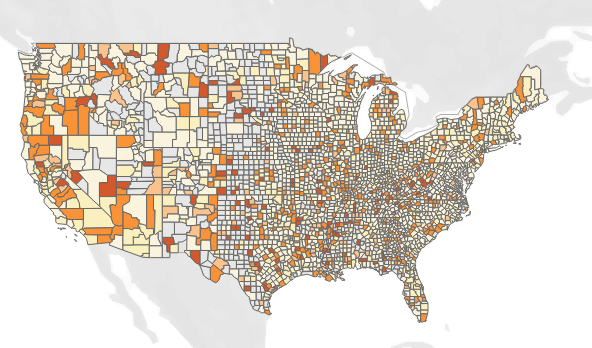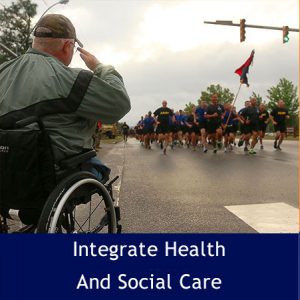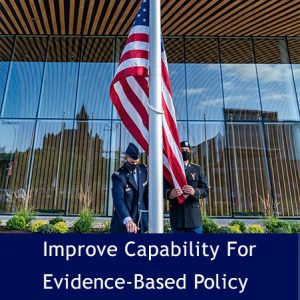IVMF Policy Priorities
-
I'm not a veteran, why is this important to me?
The National Veterans Policy Framework is rooted in the belief that good veteran and military family policy is good for all Americans. This idea manifests itself in three main ways:
- Transferability – The Policy Priorities of the National Veteran Policy Framework represent innovations in social service delivery with transferability to many other populations. Because veterans are considered a “deserving” population, they have historically been the seed from which many social service programs grow from. Federally-funded college education, home-ownership incentives and a healthcare safety net all got their start in the United States as policies aimed to serve veterans. As innovations from the National Veteran Policy Framework are considered by government, they will lay the groundwork for those innovations to spread to other populations.
- Fiscal Sustainability – An underpinning theme of this framework is increased coordination and collaboration among government, nonprofit and private sector organizations. Improved coordination and resource allocation will lead to long-term savings in spending on this population. These savings can be directed to other programs or needs taxpayers and voters see as needed.
- Security – 79% of Army recruits have a relative who served before them. The next generation of volunteers has its eyes on today’s military veterans, and their well-being will impact potential future volunteers decisions to serve. Ensuring that today’s veterans are well supported and empowered is our surest incentive to sustaining an all-volunteer force into the future.
Senate Bill 785 The Commander John Scott Hannon Veterans Mental Health Improvement Act of 2019 and House Bill 8247 Veterans COMPACT Act are two major pieces of suicide prevention legislation likely to be signed into law this year. Read the IVMF’s letter of support for the two pieces of legislation.
Need: This problem is compounded as needs increase in light of the ongoing economic and health crisis.
The VA alone cannot address the complex combination of health, economic, and social needs of this population. However, coordination with community organizations can address the issues outlined below:
- IVMF AmericaServes care coordination data indicates that 44% of veterans had more than one need. Of those, 76% requested help in multiple service categories such as housing, health, employment, etc.
- Each additional unmet service need is correlated highly with increases in the likeliness of suicidal ideation
- Those committing suicide are more likely to not be using VHA care, filling this gap in care is critical to ending veteran suicide.
- Addressing the social determinants of health is beyond the reach of the traditional VA healthcare system, and military families and other-than-honorably discharged veterans often cannot access VA programs.
- Veteran resources are often delivered in siloes across providers that do not collaborate or communicate with one another.
-
Policy Recommendation 1
Agency officials and Congress should ensure the implementation of the Commander John Scott Hannon Veterans Mental Health Care Improvement Act Section 201 follows these priorities. Congress should explore more legislative action where needed:
- Communitywide Grantmaking: Replicate the Continuum of Care model—used by Housing and Urban Development, which funds community units made up of multiple organizations—through a streamlined application process and by assigning a backbone organization to coordinate activities.
- Prioritize Community Responsiveness and Accountability: Create a grant structure that allows communities to use resources in alignment with their specific needs while still providing oversight and accountability. Move this to number two on the list
- Planning Grants: Allocate time and resources to bring local organizations together and to develop common goals and a shared agenda for coordination of services.
- Multiple Sectors: Require organizations (where possible) to partner outside of the veteran-serving space, particularly in areas where resources are scarce.
- Shared Outcomes: Provide resources to support measurement and analytics that ensure coordination is successful and appropriately meeting local needs
- Hub Funding: Provide funding for the staffing and resources needed for the hub-and- spoke model in which one organization refers a client to others in the community.
- Regular Communication: Require recipients to provide semi-annual proof of communitywide convenings or other communication mechanisms.
- Expand Technical Assistance: Expand on the existing federal technical assistance resources to help communities implement the above recommendations.
-
Policy Recommendation 2
Policy Recommendation 2: Improve the process by which community providers can identify transitioning service members moving to their communities.
- Establish a universal screener that assesses specific stressors such as unemployment, financial instability, combat exposure, adverse childhood experiences and other stressors associated with poor transition. Link the screener to navigation infrastructure (e.g. AmericaServes, Combined Arms, Augusta Warrior Partnership), identifying risk factors early and providing targeted support.
- Improve data sharing between the Department of Defense and VA to identify and engage with newly transitioned and underserved veterans in communities.
- Expand proactive outreach programs like the Solid Start and the ETS Sponsorship, which connect new veterans with resources in their communities.
- Invest in data infrastructure improvements within state and county level veteran services and health agencies to promote greater interoperability and a seamless transition from national efforts (e.g., Solid Start) to local delivery of public and community-based services.
- Support and encourage the participation of VHA facilities and VBA-certified officer in community-based networks of care and coordination.
-
Policy Recommendation 3
Expand the SAMHSA/VA Governor’s Challenge to End Veteran Suicide to All 50 States.
The SAMHSA/VA Governor’s Challenge to End Veteran Suicide represents an innovative model of collaboration and coordination that blends the benefits of an organic, locally driven approach with the resources and expertise of Federal support. Currently, 28 states are engaged in the Challenge where a wide variety of policymakers, clinicians, social service experts, nonprofits and other leaders convene to develop community-driven approaches to ending veteran suicide.
Need: The economic implications of the COVID-19 crisis have been far-reaching and devastating. The unemployment veterans and their Expand Economic Opportunity for Veterans and Military Spouses (3.15.21) families are experiencing now can undermine future financial well-being and stability. Transitioning service members, veterans and their families must be equipped with the skills that will give them access to gainful employment under the conditions of this new normal.
- Transitioning service members cite finding a job (55%) and applying military skills to civilian work (41%) among their top transition stressors.
- 62% of African American veterans cite finding a job as their number one challenge.
- There is wide variance in the quality of job training programs available to transitioning service members and spouses depending on their geography
- Nearly one-third of veteran job seekers are underemployed—a rate 15% higher than non-veterans.
- Military spouses often cannot participate in DoD Skillbridge programs unless there is available space.
- The DoD is required to permit access to veteran and military serving organizations where possible; however, installations vary in available space, resources, and commanders hold final authority in granting access. As a result, some military installations have more private support than others.

Veteran Unemployment by Country
-
Policy Recommendation 1
Develop a competitive grants program and public-private partnership model that gives funding to nonprofit organizations providing in-demand skills training and career placement to veterans, transitioning-service members and spouses. These organizations will:
- Provide trainings for careers that align with the workforce of the future;
- Provide services that are shown to promote both employment and career advancement, such as certifications, skills training and career coaching;
- Demonstrate ability to build partnerships with other organizations helping to provide a continuum of employment support from skills training, credentialing, resume assistance, job pipeline access and employer relations;
- Offer innovative programs that can deliver trainings virtually or are geographically flexible.
-
Policy Recommendation 2
Review and improve inter-agency data quality, sharing, and integration practices between VA, DOL, and DOD specific to transition and post-transition employment initiatives. Pursue a unified framework for their effective performance measurement, monitoring, and evaluation.
-
Policy Recommendation 3
Expand economic opportunity for military and veteran spouses:
- Create tax credits, and support employer coalitions that promote remote work for military and veteran spouses
- Assess the financial and programmatic implications of providing employment support to spouses of veterans in addition to spouses of service members
-
Policy Recommendation 4
- Focus policy and programmatic efforts to tailor support services for women veterans, particularly at the point of military-to-civilian transition:
- Provide grants to organizations delivering or with the capacity to deliver programs and services supporting women veterans’ unique needs. These organizations may provide services such as employment services, entrepreneurship training, childcare, short-term financial assistance, and social inclusion and support.
- These organizations could be veteran service organizations that don’t yet offer tailored programming to women veterans, or community-based organizations not yet offering veteran-specific programming.
- This grant program would both support existing organizations and drive innovation in the social sector to rise and meet an existing need.
- Expand and institutionalize existing pilot programs such as the ETS Sponsorship and the VA’s Solid Start which leverage an individualized, peer-to-peer model that lends itself to tailor services and care for women veterans
- Focus policy and programmatic efforts to tailor support services for women veterans, particularly at the point of military-to-civilian transition:
Need: While the VA conducts cutting-edge clinical research, there is growing capacity and base of research being conducted by higher education institutions and non-government organizations focused on non-clinical factors contributing to veteran overall well-being — the social determinants of health. These determinants include environment, economic stability, and social and community conditions.
Research on the social determinants of veteran health can make a significant contribution to the ongoing medical research seeking to understand the wellbeing of veterans, but it will require the VA to expand its capacity to formulate evidence-based policy through new partnerships and programs.
-
Policy recommendation 1
Congress and the VA should explore the feasibility of expanding VA’s partnerships with Universities and nongovernmental research entities, particularly on issues focused on the non-clinical dimensions of veteran life.
-
Policy Recommendation 2
Pass legislation or repurpose currently appropriated dollars to support county level data infrastructure improvements that better identify veterans in communities, and informs what types of services veterans are utilizing in complement with VA care.
-
Policy Recommendation 3
Take an inter-agency and intergovernmental approach to better understanding the needs and challenges of women veterans and how current programs and policy are positioned (or not) to meet these needs and challenges:
- Congress should create a pilot grant program administered by the Department of Veterans Affairs (VA) Office of Research and Development, in partnership with the VA’s Office of Intergovernmental Affairs, to grant funds to state veterans’ agencies for Needs Assessments conducted at the state level, with specific focus on women veterans’ needs.
- Under the passage of the Mulder Act in 2020, Transition Assistance Program (TAP) must undergo a longitudinal study to assess the quality and impact of TAP services. Congressional Representatives, VA, Departments of Labor and Defense officials should ensure that the needs and outcomes of women veterans are a central focus of this longitudinal study





